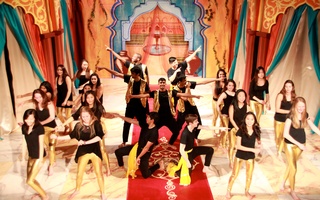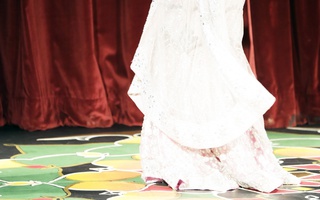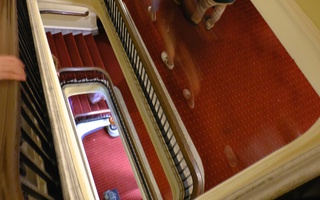{shortcode-c81a77b59d45ecfcbefeb228a0bd9c7b14a10f68} Last week, the Harvard South Asian Association presented the 27th Ghungroo, a performance combining South Asian dance and music, in Agassiz Theater. Directed by Avinash Saraf ’17, Kruti B. Vora ’17, and Madhavi L. Narayanan ’17 and produced by Kavya Pathak ’17 and Nishant Kakar ’17, Ghungroo involved about 400 student performers and included a variety of South Asian musical performance styles, from Indian classical dance to hip-hop-inspired pieces. This year’s show sold out four performances and introduced a new skit and a charity partnership focused on mental health issues.
After the show, the producers and directors sat down with The Harvard Crimson to discuss the making of Ghungroo and the new elements that they brought to the performance this year.
{shortcode-c44b1d32ba8f1028252de628e72e762cbff38855}
The Harvard Crimson: Compared to previous Ghungroo shows, what has stayed the same and what has changed this year?
Nishant Kakar: The basic layout of it continues: [There are] regular dances and there’s a senior dance. But I think what really changed this year is the entire flow of the show. Last year, each dance was pretty separate… but now the skit has really integrated all the dances together. And we also have a really strong theme of mental health through the skit, which we really put a lot of effort in to make happen. We wanted to use the stage to deliver a message to the South Asian audience, and mental health is an issue that particularly affects a lot of people in the South Asian diaspora… Now we want to use the profits to donate to this particular organization called CHAI [Counselors Helping (South) Asians/Indians], which is related to mental health. We’re hoping that this year could be a stepping stone for future shows to put in more and more.
THC: How many people were involved in the creative process of the show?
Kavya Pathak: We have eight regular dances, and each has two choreographers…. There are nine segments in senior dances, and each has two to four choreographers. We have a tech team of 20, a production team of 12, three directors, and a lot of dancers.
Nishant Kakar: We try to make it as inclusive as possible for everyone on campus. People don’t have to audition for our show, which is really important. We want to give everyone a chance to be on stage.
THC: How did you, as directors, envision a way to address the issue of mental health?
Kruti Vora: One of the challenges that we faced when planning this is that we really wanted to address this issue, but we also understand that the audience want a light-hearted and fun show. [Mental health] is not an issue that we should be trivializing at all, and we want to address it in a very respectful and meaningful way. So our skit directors especially did an amazing job balancing this light-hearted and fun aspect where we can still make jokes about Tinder and “riding the D,” but we can [also] have these incredible monologues and dialogues that we hope would really make people talk about this issue beyond just the theatre.
THC: What inspired the sets, costumes, and other visual elements of the show?
Kruti Vora: The set is wedding-themed because the show is set at a wedding. So the little circular thing in the back, the gate, with the draping, that’s called a Mandap. That’s normally in Hindu weddings. The design on the floor with the green that’s incorporated is called a Mandala. The colors of Indian weddings, I guess, are more like red and gold. More south Indian weddings and Muslim weddings highlight green, and the design of colors and geometry is more like a Muslim-influenced design. So we really try to blend in many different cultures. This is the first year that we made a policy that all the dances had to choose at least one non-Hindi song to try and represent different cultures as well.
Avinash Saraf: One thing I want to add is that we’re not trying to represent South Asia. We are trying to borrow from these cultures. But ultimately our experience as American South Asians is what informs a lot of what goes on in the show. We’re borrowing from a culture that we all find to be integral parts of our identities, and we are proud to show this culture to everyone who comes to see this show.
Read more in Arts
The Walking Dead: "Knots Untie"Recommended Articles
-
WILL THREE BOTTLE LABELS GET SCHOLARSHIP IN 1987?Harvard commencements 50 years from now will be financed and broadcast by beer barons, and scholarships awarded on the basis
-
 Ghungroo 2015 Celebrates Diversity, Inclusivity
Ghungroo 2015 Celebrates Diversity, Inclusivity -
'SKETCH' Brings Laughs to Adams Pool TheaterNow in its second year, “SKETCH,” which ran from March 26th to March 28th in the Adams Pool Theater, is Harvard’s stab at creating its own live, entirely student-written sketch comedy show.
-
 Ghungroo Performance Adds Mental Health Focus
Ghungroo Performance Adds Mental Health Focus -
 Ghungroo 2018: Harvard SAA Celebrates 30 Years of Ghungroo
Ghungroo 2018: Harvard SAA Celebrates 30 Years of Ghungroo













